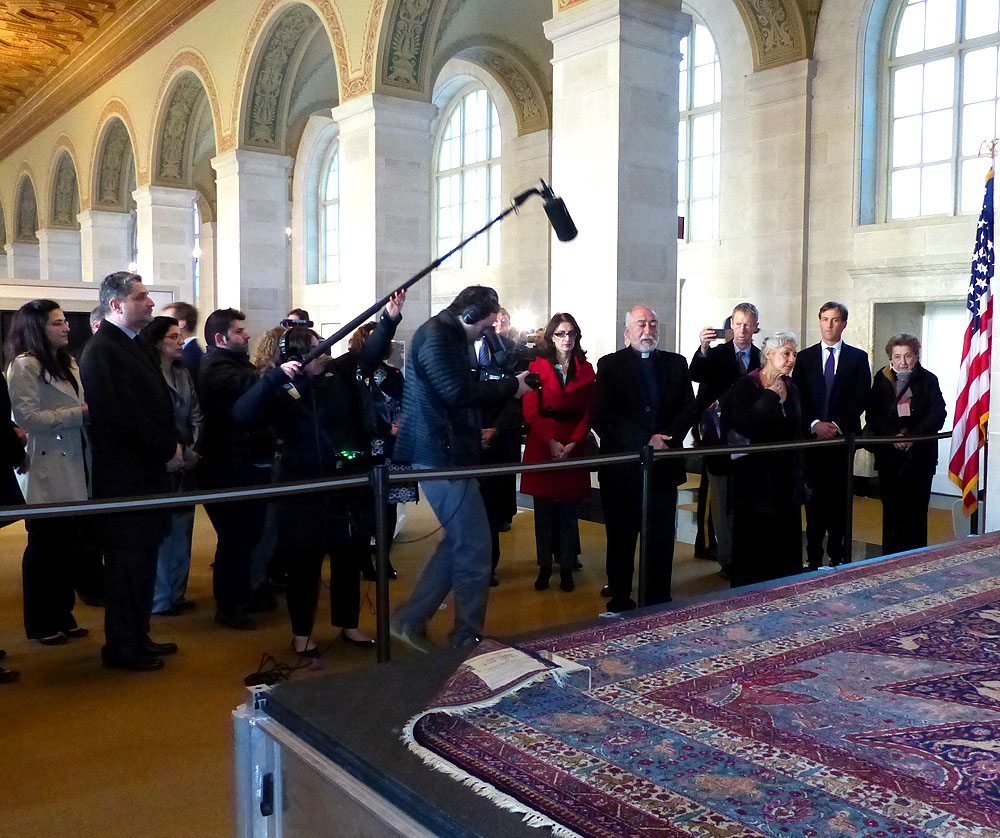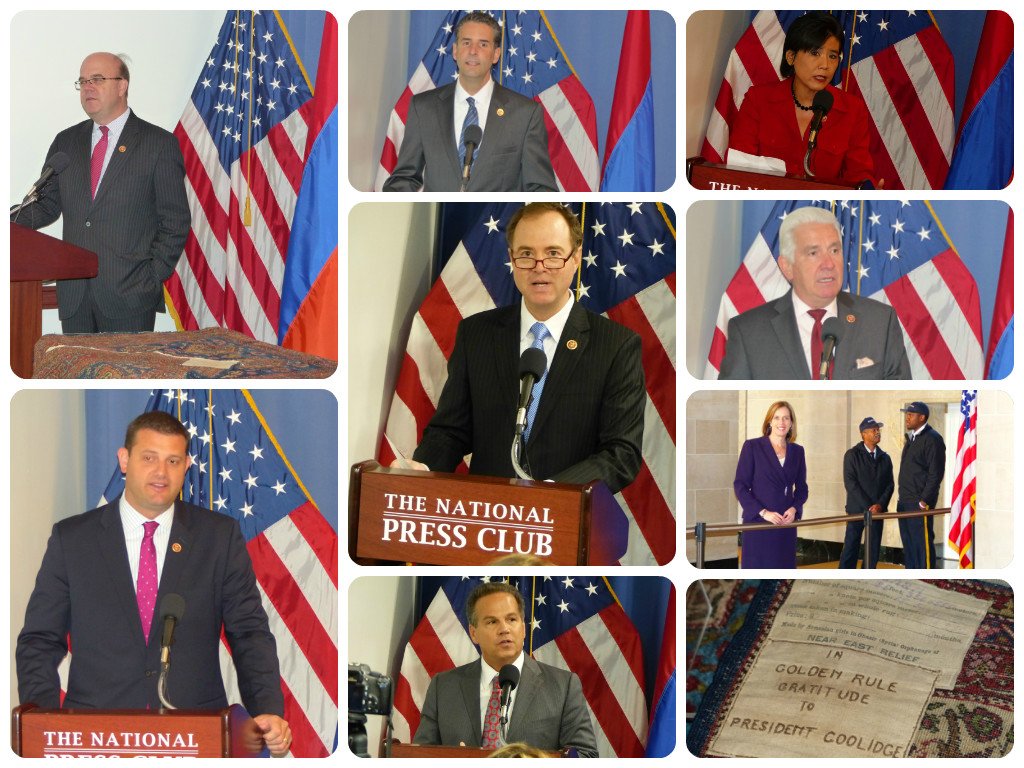Call for End to Ankara’s Gag-Rule against US Reaffirmation of Armenian Genocide
WASHINGTON—Members of Congress joined with Armenian-American organizations on Nov. 18, in welcoming the display of the White House’s historic Armenian Orphan Rug and in urging the Obama Administration to reject the gag-rule that Turkey has long enforced against honest American discourse about the Armenian Genocide, reported the Armenian National Committee of America (ANCA).

The
The Armenian Orphan Rug, woven by child survivors of the genocide, was gifted to President Calvin Coolidge in 1925 in appreciation of U.S. humanitarian assistance.
Representatives Adam Schiff (D-Calif.) and David Valadao (R-Calif.) were joined by fellow colleagues Judy Chu (D-Calif.), David Cicilline (D-R.I.), Katherine Clark (D-Mass.), Jim Costa (D-Calif.), James McGovern (D-Mass.), and John Sarbanes (D-Md.) at the National Press Club for a kick-off press conference, followed by a special blessing by Fr. Sarkis Aktavoukian and viewing of the Armenian Orphan Rug—also known as the Ghazir Rug—at the White House Visitor Center.
Dr. Martin Deranian, author and Armenian Orphan Rug expert; Hratch Kozibeyokian, a member of the Armenian Rug Society Board of Directors; Missak Kelechian, a member of the ANCA Western Region’s “America We Thank You: An Armenian Tribute to Near East Relief” initiative; Aram Hamparian, executive director of the ANCA; and Bryan Ardouny, director of the Armenian Assembly of America discussed the significance of the Armenian Orphan Rug in both American and Armenian history.
Display ‘no substitute’ for U.S. reaffirmation
As Members of Congress celebrated the release of the Armenian Orphan Rug from White House storage, they all referenced the need for formal and unequivocal U.S. reaffirmation of the Armenian Genocide.
“The Ghazir Rug is not just a carpet; it is a tangible connection to the first genocide of the 20th century—a silent, beautiful rebuttal to those who deny the murder of 1.5 million men, women, and children in a campaign of mass murder, forced marches, rape, and looting that befell the Armenian people from 1915-23,” explained Rep. Schiff, who over the past year led the effort to secure White House display of the artifact after its more than 30 years in storage.
“As the world prepares to commemorate the centennial of the genocide, the Ghazir Rug brings to life the shattered families and the mass inhumanity that was visited upon the Armenian people. And I hope that it can serve to educate a new generation of Americans about one of the great tragedies of history and leads to a redoubling of efforts in 2015 to finally and forever honor the genocide of the Armenians without equivocation.”
Rep. Valadao told press conference attendees, “My Congressional District is home to a very large Armenian population that has a very strong presence in our community. The Armenian Orphan Rug is a shared piece of American and Armenian history that should be available to the public. I am excited my colleagues and I were able to help secure a public display of the rug.”

Schiff and Valadao secured the support of over 30 Members of Congress in November 2013, culminating in a successful year-long campaign to encourage the White House to display the historic treasure.
“The Armenian Orphan Rug symbolizes the enduring Armenian spirit,” said Rep. Sarbanes. “As the world prepares to mark the centennial of the Armenian Genocide, I hope that the display of the Orphan Rug will spark an honest discussion about one of history’s darkest chapters and lead finally to a formal and official recognition of the genocide.”
“The Armenian Orphan Rug exhibit is an opportunity for Americans to see with their own eyes a moving, physical reminder of the Armenian Genocide,” said Rep. Clark. “It’s an incredible and important milestone for the White House to display its 4 million knots woven by children whose lives were devastated nearly 100 years ago. It’s long overdue for the U.S. to formally recognize the Armenian Genocide.”
“The Armenian Orphan Rug is a shared piece of American and Armenian history that belongs to the American people,” said Rep. Costa. “Today represents progress, but falls short of the full and formal recognition of the Armenian Genocide that should be a cornerstone of U.S. human rights policy.”
“This great artifact is both a symbol of the strong relationship between Armenia and the U.S., and a stark reminder about the first genocide of the modern era where 1.5 million Armenians perished at the hands of the Ottoman Empire,” Rep. Cicilline told attendees. “Together with leaders in the American-Armenian community we successfully worked with the White House to make sure the Armenian Orphan Rug and its historical meaning will be shared with the country.”
“For the last 10 years, the Armenian-American community has fought to get this rug released and displayed to the public,” said Rep. Chu. “This is only a first step. This story reinforces why Congress must pass a resolution to recognize the Armenian Genocide.”
“Worcester, Mass. is home to one of the oldest Armenian communities in America, and I’m very proud to be here today with George Aghjayan from Worcester and my good friend Dr. Martin Deranian from Shrewsbury, who is the author of such an important book on the Armenian Orphan Rug,” said Rep. McGovern. “While we are all proud and pleased that the Armenian Orphan Rug is being displayed at the White House [Visitors Center] this week, it is no substitute for the president recognizing the Armenian Genocide. The U.S. needs to formally recognize the Armenian Genocide now, before the last survivor is gone.”
Display fails to characterize moral and historic dimensions
ANCA Executive Director Aram Hamparian, Legislative Affairs Director Raffi Karakashian, and ANC Central Massachusetts Chairman George Aghjayan were first in line at the White House Visitor Center to view the Armenian Orphan Rug on the morning of the display opening. Magnificent in its presentation, the accompanying plaque described the genocide survivors who wove the rug only as having been “orphaned during World War I,” with no reference—either directly or indirectly—to the crime that precipitated the overwhelming U.S. outpouring of humanitarian support.
Hamparian explained, “Today’s White House display of the Armenian Orphan Rug is a testament to the generous spirit of the American people, whose unprecedented humanitarian assistance efforts saved hundreds of thousands of survivors of the Armenian Genocide, including the Armenian orphans who meticulously crafted this unique artifact of American and Armenian history. Unfortunately, the display’s description—using evasive and euphemistic language—deprives this profoundly important work of art of its moral and historical meaning. It also deprives viewers of the opportunity to learn about the Armenian Genocide and draw lessons from this experience to prevent future atrocities.”
Hamparian went on to “thank Congressmen Schiff and Valadao and all their colleagues who helped make this display possible, and whose efforts are already sparking national and international attention to this still unpunished crime. We remain troubled that on the eve of the Armenian Genocide Centennial, Turkey’s gag rule is still in force and remain committed to a truthful and just international resolution of this crime.”
After long decades in storage, and following Congressional pressure and a nationwide Armenian-American grassroots campaign to secure its release, the White House agreed to the display of the Armenian Orphan Rug as part of an exhibit at the White House Visitors Center from Nov. 18-23. The exhibit—entitled, “Thank You to the United States: Three Gifts to Presidents in Gratitude for American Generosity Abroad”—will showcase the Ghazir Rug, as well as the Sèvres vase, given to President Herbert Hoover in appreciation for feeding children in post-World War I France, and the Flowering Branches in Lucite, given to President Barack Obama in recognition of American support of the people of Japan after the devastating earthquake and tsunami in 2011. These three gifts to American presidents will be on display so visitors to the White House and those wishing to see the artifacts can view them.
The Armenian Orphan Rug measures 11′7″ x 18′5″ and is comprised of 4,404,206 individual knots. It took Armenian girls in the Ghazir Orphanage of the Near East Relief 10 months to weave. The rug was delivered to President Coolidge on Dec. 4, 1925, in time for Christmas, with a label on the back of the rug that reads: “IN GOLDEN RULE GRATITUDE TO PRESIDENT COOLIDGE.”
The controversy surrounding the Armenian Orphan Rug erupted in October 2013, when the Washington Post and National Public Radio reported the White House’s abrupt and unexplained reversal of its agreement to lend the rug for a Dec. 16, 2013 exhibition at the Smithsonian Institute, organized in cooperation with the Armenian Cultural Foundation and the Armenian Rugs Society. In an interview with Public Radio International (PRI), Washington Post art critic Philip Kennicott noted that while the White House has not offered an explanation for the reversal in decision, it is likely due to the U.S. government’s deference to Turkey’s international campaign of genocide denial.



Amen and “shanoragulum” to all those involved in making this happen. My grandparents, great aunts and uncles – Chouljian and Racoobian families – could have been among the orphans who made this beautiful rug. It’s evoking fond memories of similar rugs I grew up with proudly woven into the fabric of their homes.
The Armenian Orphans’ Carpet displayed in the White House after a great effort from offspring of the genocided race of 1915, is not a rug… I will repeat, any such beautiful piece, is a real Carpet, not a rug and never will be.
The Orphans’ Carpet is shinning… still
Like crystals…like diamonds…with its silk and wool threads
Orphans’ petite hands were lights
Hence till today still give lights
Created by their angelic, innocent fingers
Filled with joyful spirits from the past days
That passed, none able to return …
They lost their warm homes …Their Altars
Their belfries with voices of bells ringing on Sundays…
Calling them to hymnate… “Surp~Surp” (divne~divine)
They lost their beloveds’ hugs…
Their toys… their garden with flowers and fruitful trees…
Their photos… their antiques
Their musical instruments: Pianos, Duduks, Violins, Drums, …
Still they wanted to please
Those who saved them to breathe…
Who made them to sing
Their Gomidasian songs: Groong (crane), Andoni (homeless), …
Can anyone understand how those orphans
weaved that colorful Carpet
under the moonlight to reach a large size:
5.6 x 3.6 m (18.5 X 11.7 ft) with 4,404,206 knots?
By laughs? … by jokes… by songs?
Or eyes filled with trillion tears… stagnated blood ..?
Still they did pray to God
That they were saved from butchers’ hands…
Sylva Portoian, MD
(A poetic soul shines from well-known Genocide)
Written Instantly
November 19, 2014
Your poem is as beautiful and inspiring as the Carpet. Thank you.
i am not Armenian. My wife is. We have been tomArmenia and will be returning in 2015. This exhibition took too long
Why does the Armenian community not hold the President accountable for his actions? When he ran the first time, he courted the Armenian vote and gave every reason to think he’d deal with the genocide issue and acknowledge it. He backtracked. Where is the outrage by the American Armenian community? I voted for the president so this is not partisan politics. Recognition will not come by itself. Representatives and Senators must be pressured and both the mass media and social media must be used effectively
Bruce,
We Armenians do not have the leverage that Turkey has with it’s trade, size and geopolitical place in the middle east. It’s actually amazing that we have gotten this far simply based on the moral importance of remembering and understanding genocides and countering their denials.
Turkey is no longer able to suppress it’s history from being discussed and they have had to change their tactics. It’s becoming clearer to the world that any reluctance to label it as genocide is because of geopolitical relations with Turkey and not based on any authentic controversy.
*** Thank you Bruce, well said.
Shame on you Amerca that your presidentis a lier